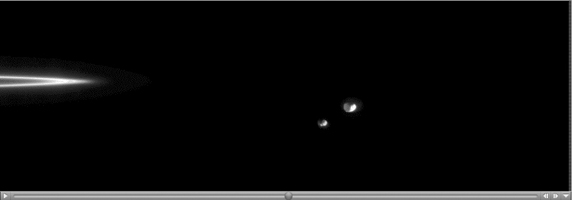
Click on the image for movie of
Janus-Epimetheus SwingIn this movie sequence, Cassini watches Saturn's moon Janus and Epimetheus in their orbital dance as the F ring slides out of view.
These two moons are locked in a gravitational tango that causes them to swap positions about every four years, with one becoming the innermost of the pair and the other becoming the outermost.
The movie was created from eight original images taken over the course of 11 minutes as the spacecraft's narrow angle camera remained pointed toward Epimetheus. Although Janus (181 kilometers, or 113 miles across) moves a greater distance across the field of view, Epimetheus (116 kilometers, or 72 miles across) also moved perceptibly during this time. The images were aligned to keep Epimetheus close to the center of the scene. Additional frames were inserted between the eight Cassini images to smooth the appearance of the moons' movement--a scheme called interpolation.
The images were taken in visible light with the Cassini spacecraft narrow-angle camera on Sept. 8, 2005, at a distance of approximately 1.8 million kilometers (1.1 million miles) from Janus and 1.7 million kilometers (1 million miles) from Epimetheus. Image scale is 11 kilometers (7 miles) per pixel on Janus and 10 kilometers (6 miles) per pixel.
The Cassini-Huygens mission is a cooperative project of NASA, the European Space Agency and the Italian Space Agency. The Jet Propulsion Laboratory, a division of the California Institute of Technology in Pasadena, manages the mission for NASA's Science Mission Directorate, Washington, D.C. The Cassini orbiter and its two onboard cameras were designed, developed and assembled at JPL. The imaging operations center is based at the Space Science Institute in Boulder, Colo.
For more information about the Cassini-Huygens mission visit http://saturn.jpl.nasa.gov/home/index.cfm. The Cassini imaging team homepage is at http://ciclops.org.

